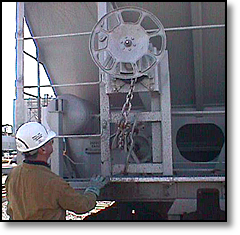Safety is our number one concern. Prior to inspecting a hopper car or carrying out loading/unloading operations a few safety items will be covered. These will ensure that the hopper car is properly secured, grounded, and safe to work around.

Place a "blue flag" warning sign. Before inspecting, loading, or unloading any hopper car, a "blue flag" warning sign must be placed at least 25 feet from the open end of the hopper car. This sign will ensure that others working in the area are aware that someone is working around the hopper car. If the track is open from both ends then a "blue flag" warning sign must be placed at each end.
The warning sign(s) must remain in place until you complete your inspection, and if applicable until all loading/unloading lines are disconnected and the hopper car is ready to move.
A good practice is to remove the 'blue flag" sign just prior to switching operations.
The warning sign(s) must remain in place until you complete your inspection, and if applicable until all loading/unloading lines are disconnected and the hopper car is ready to move.
A good practice is to remove the 'blue flag" sign just prior to switching operations.

Signs such as this one are in place to assist in the safe placement of hopper cars. Failure to excercise caution could result in someone being crushed or badly injured.
 |
 |
Lock out Derailers or Track Switch(es). Derailers and/or switches are used to isolate the track section that your hopper car is on. They need to be locked to prevent unauthorized hopper car movements. If the track is open from both ends then the derailers or track switches must be locked out at both ends.
The derailers and/or switches must remain locked out until all loading/unloading lines are disconnected and the hopper car is safe to move. A good practice is to remove the derailers and unlock the switch(es) just prior to switching operations. The key(s) should be maintained as per your Lock, Tag & Try Program.
All affected personnel should be notified prior to switching operations. No one should be working on or remain in close proximity to the hopper car during a switching operation. The exception to this guideline will be the work performed by the hopper car switching crews.
The derailers and/or switches must remain locked out until all loading/unloading lines are disconnected and the hopper car is safe to move. A good practice is to remove the derailers and unlock the switch(es) just prior to switching operations. The key(s) should be maintained as per your Lock, Tag & Try Program.
All affected personnel should be notified prior to switching operations. No one should be working on or remain in close proximity to the hopper car during a switching operation. The exception to this guideline will be the work performed by the hopper car switching crews.

Verify that the handbrake is working by making sure each brake shoe is making contact with its adjacent wheel set. Also, handbrake systems that apply braking force to both trucks, depending on the current state of adjustment, may not have every brake shoe in contact with its adjacent wheel set. Consider the latter system effective if at least 80% of the brake shoes are in direct contact the hopper cars wheels.
The handbrake should be left set after inspecting, loading, or unloading the hopper car to prevent it from drifting. The handbrake should be released just prior to moving the hopper car.
.jpg)
Chock Wheels. In addition to setting the handbrake, the wheels of the hopper car being worked on should be chocked.
All hopper cars are equipped with roller bearing trucks. Roller bearings make it much easier for the hopper car to roll free if wheel chocks are not used. Wheel chocks should remain in-place until the hopper car is switched. This will reduce the possibility of the hopper car drifting should the handbrake prove to be defective.
All hopper cars are equipped with roller bearing trucks. Roller bearings make it much easier for the hopper car to roll free if wheel chocks are not used. Wheel chocks should remain in-place until the hopper car is switched. This will reduce the possibility of the hopper car drifting should the handbrake prove to be defective.

Grounding lugs are rarely standard equipment on a hopper car and therefore it is the loaders responsibility to apply grounding clamps to a metallic component of the hopper and bond all loading attachments to the unit. Care must be taken to properly prepare the surface where the grounding clamp is to be applied so that it makes contact with a clean paint free surface. The person attaching the ground clamp has the added responsibility to make sure the grounding cable is not frayed or otherwise damaged and it’s a good practice to have your grounding system inspected annually by a qualified electrician.
Note: Just sitting on the rails does not ground the hopper car. Lubrication used between the truck and center plate connecting the two may act as an insulator, thus preventing the car from being grounded.


Check Safety Showers for safe operation. Regulations require an operator loading or unloading a hopper car to identify the location of the nearest safety shower. Always check the nearest safety showers to make sure it operates correctly before starting work in the area.
Personal Protective Equipment. When inspecting, loading or unloading hopper cars, it is important to correctly use all recommended personal protective and safety equipment.



